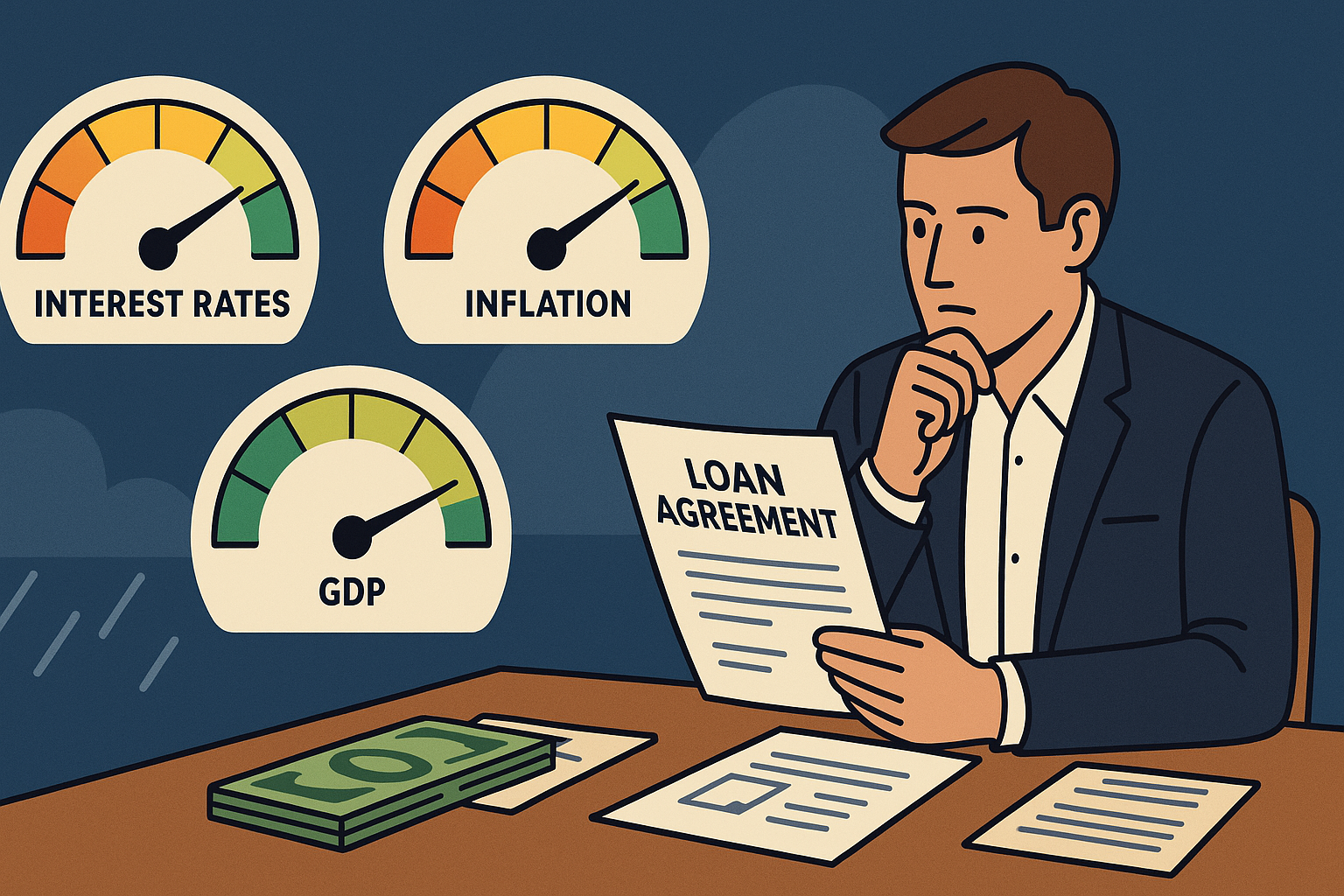1 (800) 584-0324
Economic indicators business financing, when is the best time to apply for a business loan? The answer depends not just on your company’s performance, but also on broader economic conditions. By tracking key economic indicators business financing, you can better time your borrowing, negotiate stronger terms, and avoid costly surprises.
This guide explains the most important economic and market metrics to monitor before seeking financing—whether you’re planning a working capital line, an equipment loan, or growth capital.
Why Economic Indicators Matter for Financing
- Loan affordability: Interest rates and inflation directly impact repayment costs.
- Credit availability: Bank lending standards tighten or loosen with the business cycle.
- Investor appetite: Equity and private credit markets react to growth trends and capital flows.
- Risk perception: Economic slowdowns increase scrutiny from lenders.
In short: economic conditions determine both the cost and the availability of financing.
Key Economic Indicators for Business Financing
1. Interest Rates (Fed & BoC Policy Rates)
- Set by the Federal Reserve (U.S.) and the Bank of Canada.
- Affect prime rates, which determine business loan costs.
- If rates are expected to rise: secure financing early at lower fixed rates.
2. Inflation Rate
- High inflation erodes purchasing power and prompts central banks to raise rates.
- Impacts both loan affordability and working capital needs.
- Watch the U.S. CPI (Consumer Price Index) and Canada’s inflation reports.
3. GDP Growth
- Strong GDP growth signals economic expansion, increasing lender confidence.
- Weak or negative growth (recession risk) may tighten credit supply.
- U.S. Bureau of Economic Analysis and Statistics Canada publish quarterly updates.
4. Employment Data
- Strong employment = robust consumer demand → better conditions for borrowing.
- High unemployment may cause lenders to apply stricter credit standards.
5. Credit Availability Indexes
- The Federal Reserve’s Senior Loan Officer Opinion Survey (SLOOS) tracks lending standards.
- The Fed’s Small Business Credit Survey (fedsmallbusiness.org) reports SME access to capital.
- These indexes reveal if banks are easing or tightening credit.
6. Consumer & Business Confidence
- Surveys like the Conference Board Consumer Confidence Index and NFIB Small Business Optimism Index measure sentiment.
- High confidence = easier financing conditions; low confidence = lenders more cautious.
7. Capital Market Conditions
- For larger businesses: private credit spreads, bond yields, and equity market volatility.
- Wider spreads = more expensive debt; volatile markets reduce investor appetite.
Economic Indicators Business Financing: Practical Tips
- Track central bank signals: Rate hikes or pauses can change loan affordability overnight.
- Time your borrowing: Secure loans before rates rise, but avoid over-leveraging in downturns.
- Consider refinancing: Lock in fixed rates if inflation or rates are expected to stay high.
- Diversify funding sources: When banks tighten, look at alternative lending or asset-based financing.
- Stress-test scenarios: Model your loan repayments under different interest rate or GDP outcomes.
U.S. vs Canada: What to Watch
- United States:
- Fed Funds Rate
- CPI (inflation)
- SLOOS + Fed’s Small Business Credit Survey
- NFIB Small Business Optimism Index
- Fed Funds Rate
- Canada:
- Bank of Canada Overnight Rate
- CPI inflation report (Statistics Canada)
- BDC/CSBFP lending program updates
- Canadian Federation of Independent Business (CFIB) confidence index
- Bank of Canada Overnight Rate
Reference Summary
| Indicator | Why It Matters | Reference |
|---|---|---|
| Interest Rates | Loan costs rise when central banks hike rates; falling rates make borrowing cheaper and encourage lending. | Bankrate, Investopedia |
| Lending Standards | When banks loosen lending standards, more businesses qualify for loans; tight standards make financing harder. | AP News |
| Economic Growth / Business Cycle | Strong GDP growth and expansion phases increase lender confidence; recessions reduce credit supply. | Investopedia, Wikipedia |
| Small Business Lending Index (SBLI) | Tracks small business loan activity; rising SBLI signals increased demand and lender confidence. | Wikipedia |
Planning to secure financing? Agile Solutions helps businesses in the U.S. and Canada analyze economic indicators and structure loans that balance cost, timing, and risk.
👉 Book a consultation today at agilesolutions.global or email us at info@agilesolutions.global
#EconomicIndicators #BusinessFinancing #InterestRates #Inflation #CreditAvailability #WorkingCapital #SBA #CSBFP



